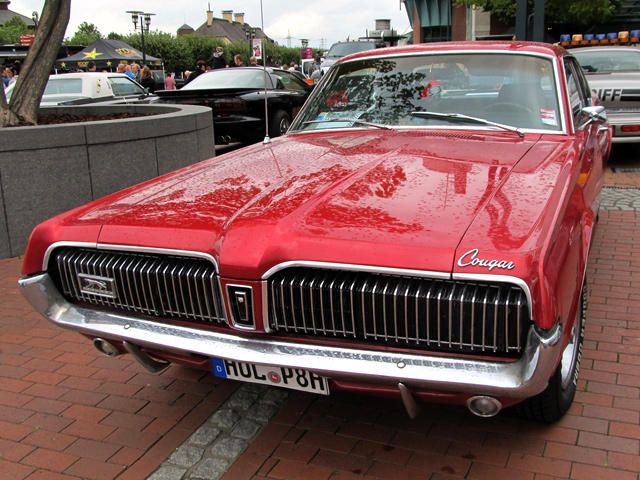
Pity the poor Mercury Cougar. What started out as a largely successful effort to make a more sophisticated form of the Mustang ended up falling victim to Ford's general inability to define the Mercury brand. The Cougar came out in 1967, and shared a platform with the newly face-lifted Mustang, and was Mercury's only performance model. A healthy options list meant that the Cougar could be made into an impressive performance car.
However, it didn't take long for it begin the move to a more luxury-oriented coupe, a sort of budget version of the Lincoln Continental. The first Cougar, introduced in 1967, was all pony car. The car slotted in between the Mustang and the Thunderbird, and borrowed elements from each, although mostly the Mustang. The platform was from the Mustang, but it was much more than a rebadging. The sheet metal was different, and the wheelbase had been stretched by three inches. Another key difference was the engines offered for the Cougar. Unlike nearly every other pony car, there was no base six-cylinder option, and Ford's 289 V8 served as the base engine.
Amazingly, Mercury kept this V8-only engine lineup for the Cougar all through the oil embargo, and didn't offer a six-cylinder until 1981. First-gen Cougars even had the option of a monstrous 427 or 428 Cobra Jet V8 engines. These were incredibly expensive in comparison to the base vehicle, but they served the Ford crowd as good counter to the COPO Camaros being driven by their bitter rivals in the Chevy camp. Sales were excellent, especially in '67, but it wouldn't last. The first redesign came in 1971, and although the new Cougar wasn't much bigger than its predecessor, the engine option list had shrunk significantly.
There were two different versions of the 351 V8 and a 429, but the big block was dropped for the 1972 model year, never to return. This Cougar was still based on the Mustang, but as the pony car niche died off and Mercury shifted the focus of the Cougar to being luxury coupe, the platform sharing made less and less sense. So another redesign came in 1974, and the Cougar switched its chassis to that of the bigger Ford Elite. Mercury was intended as a sort of luxury-light division of Ford, and the third-gen Cougar started to receive more and more of the trappings of a seventies American luxury car, including those all-important opera windows.
Manual transmissions were no longer offered, and Mercury's advertising now openly drew comparisons to the Continental. Performance just wasn't fashionable anymore, and luxury was in. Cougar sales figures for the third-gen model show that the shift had paid off, and the big, heavy luxury-ish coupes had become Mercury's bread and butter. This trend continued through the fourth generation Cougar, but in 1980 it switched to the smaller and lighter Fox platform, also used by the Mustang. Mercury could have used this opportunity to reintroduce it as a pony car, just as the new Fox-body Mustangs were cleaning up that car's reputation after the Mustang II debacle.
They didn't though, and a selection of weak engines failed to so much as hint at any performance roots the nameplate might have had. For the sixth generation, the Cougar stayed small and improved in both looks and performance. It was a far cry from the '67 model, but a new notchback body style and a 5.0-liter V8 borrowed from the Mustang were at least done in the spirit of the old car. There was even a performance suspension package and manual transmission offered. Sales improved as Mercury made baby steps back toward performance. Then came a redesign in 1989 and it all went right down the tubes.
The wheelbase grew by a massive nine inches and there wasn't even a V8 available at launch. A V8 was quickly found to fit under the Cougar's hood, but sales slid until hitting a then-record low in 1997. Mercury killed off the Cougar after the 1997 model year, but went back on this decision and brought out a new Cougar for the 1999 model year. The new Cougar was front-wheel-drive for the first time, and no V8 was ever offered from this eight-generation model. This was essentially a bigger version of the European Ford Puma, and borrowed from the Ford Contour SVT parts bin.
There was a brief hope that Mercury making a Cougar for a new era. Sport compacts were all the rage in the late nineties, and if Mercury managed to hop on this trend the same way they had jumped on the pony car craze, the Cougar might have once again become a name associated with speed. The car's advertising was aimed at younger buyers, and Ford built impressive high-performance concept versions of the car, ramping up excitement for the newly rethought Cougar. But then, in much the same way that Mercury's place in Ford's lineup was becoming increasingly unclear, nothing was ever done with the Cougar.
The performance concepts never found their way to showrooms, and it was hardly a luxury coupe anymore. The Cougar had simply become this ill-defined compact coupe which cost a little bit too much, for reasons which nobody could ever satisfactorily explain. Mercury killed off the Cougar in 2002, followed a few years later by Ford killing off Mercury. It's hardly surprising that the Cougar met the fate it did, no matter how truly excellent the first generation of the car was. It continues to serve as a warning that, if you aren't sure about the direction your product should take, simply putting out something mediocre will not work as a substitute.

